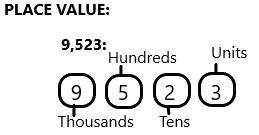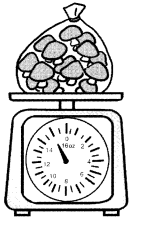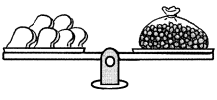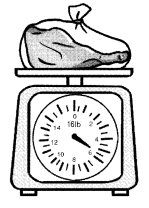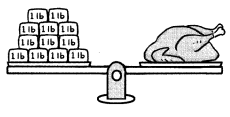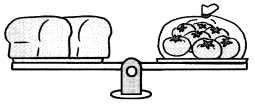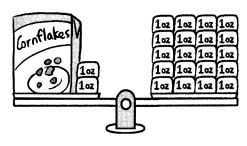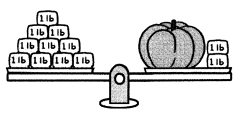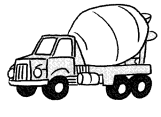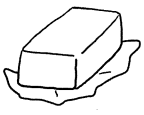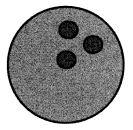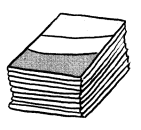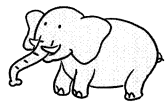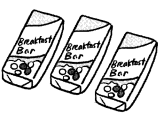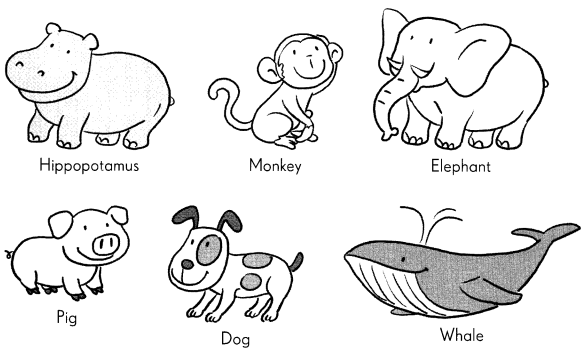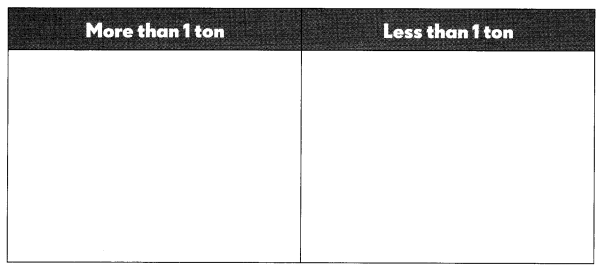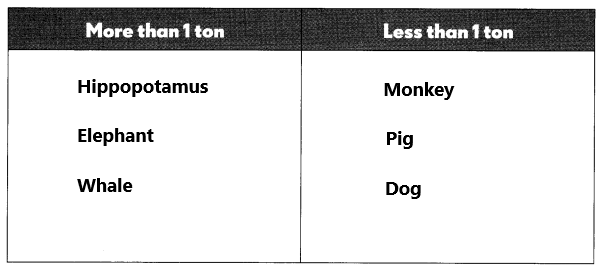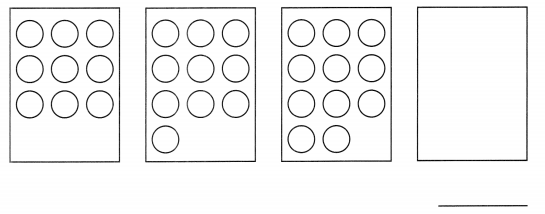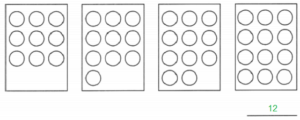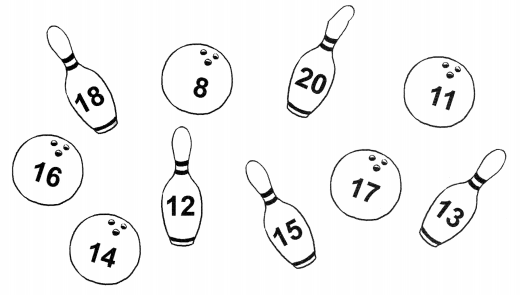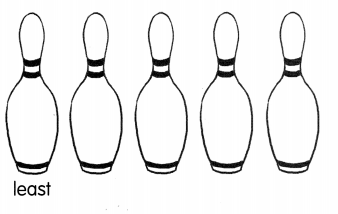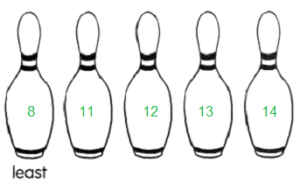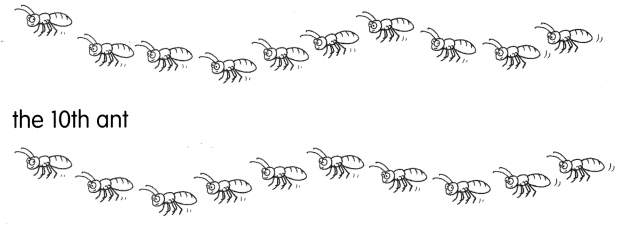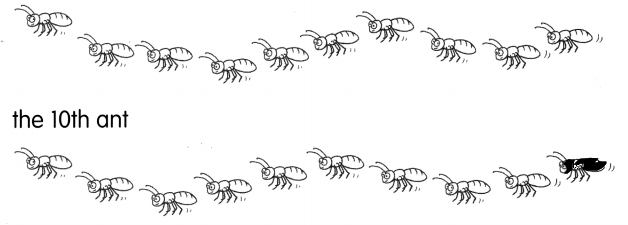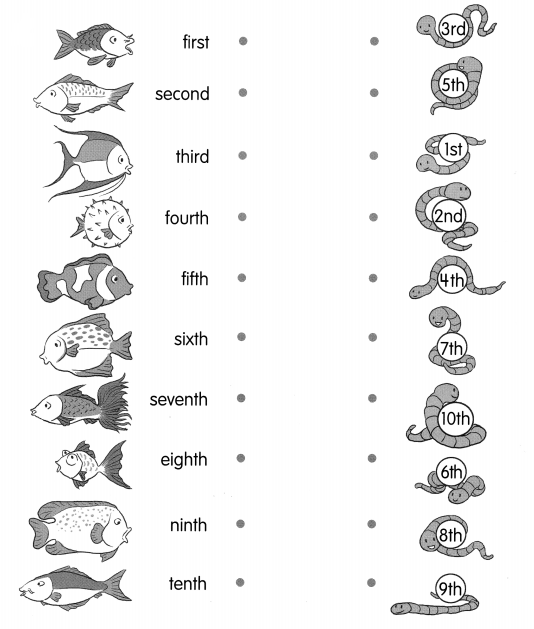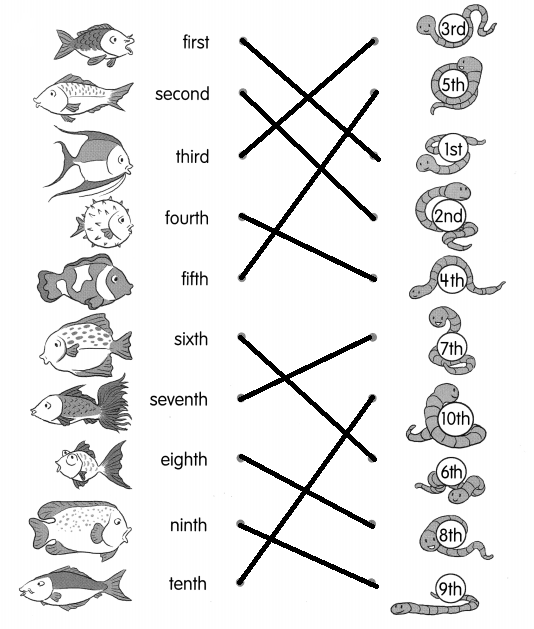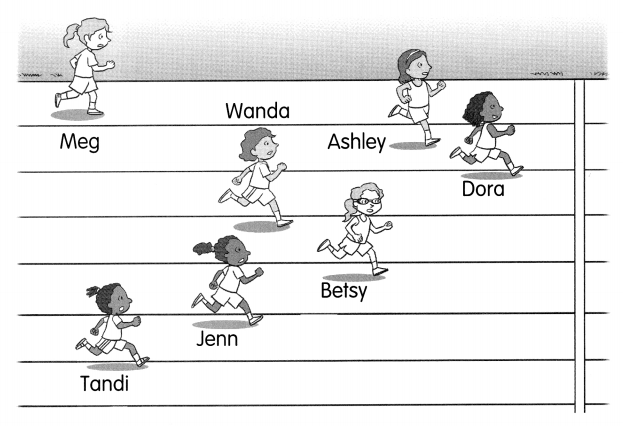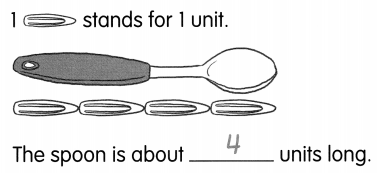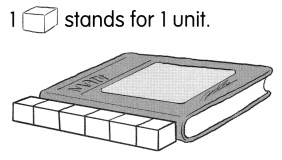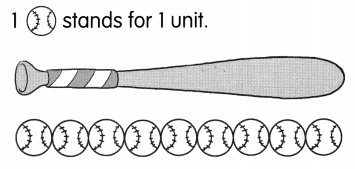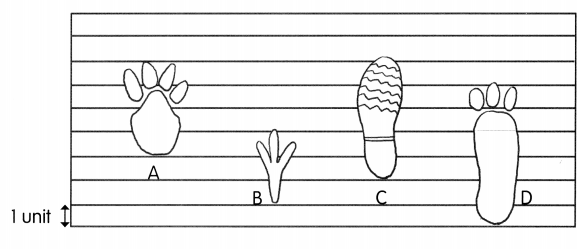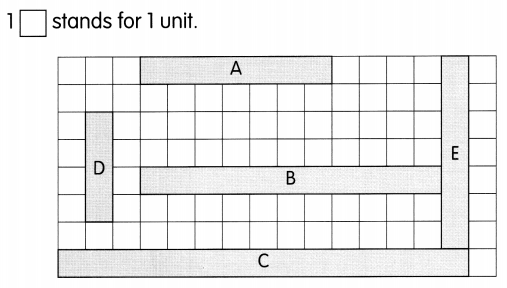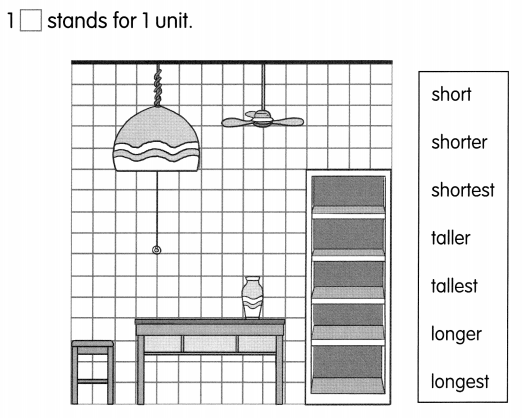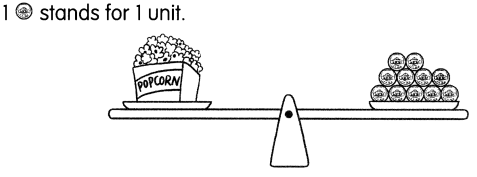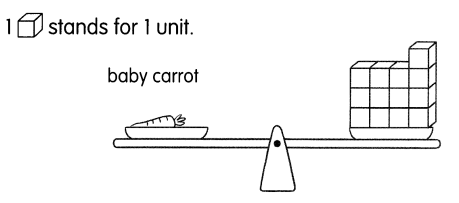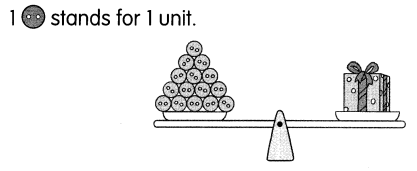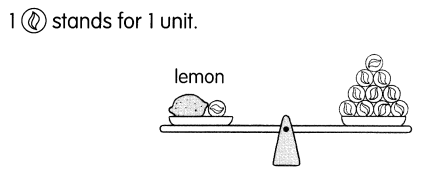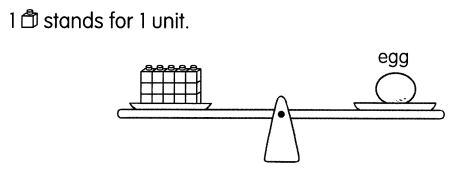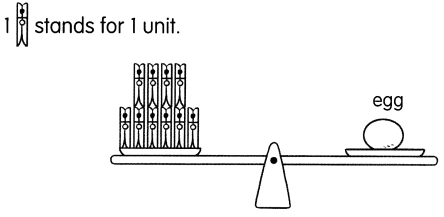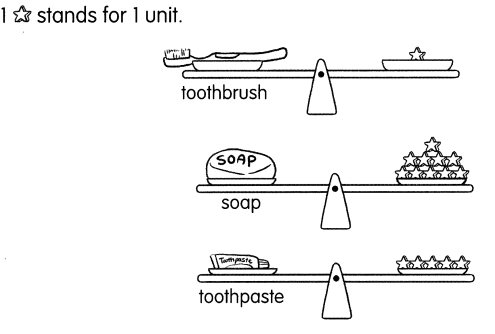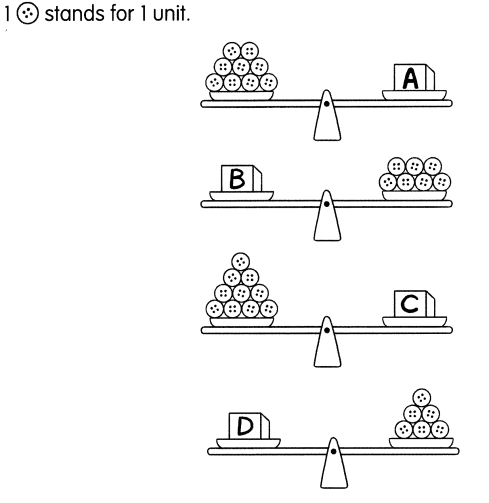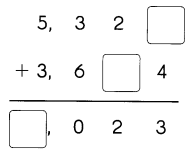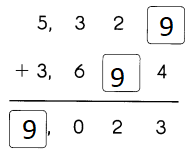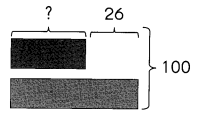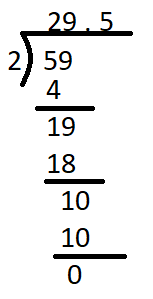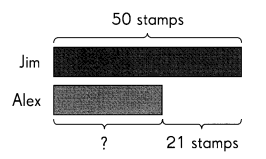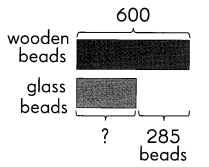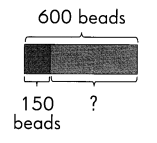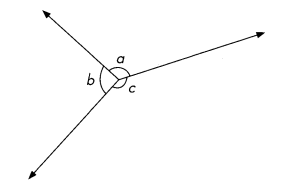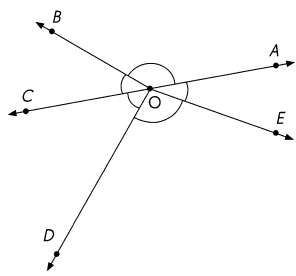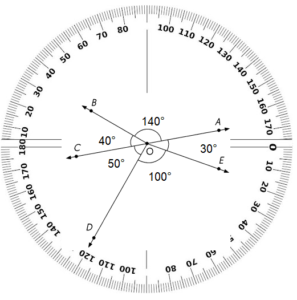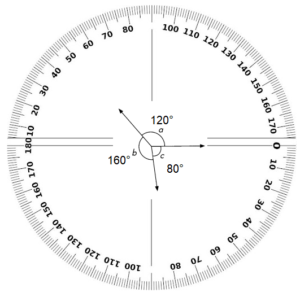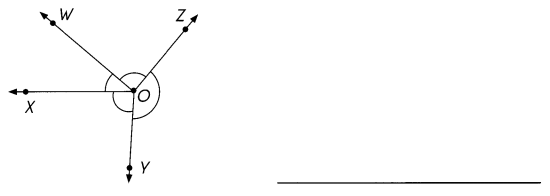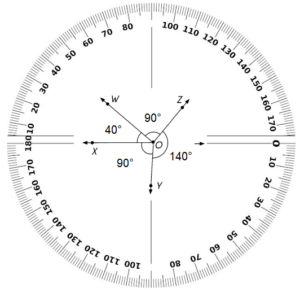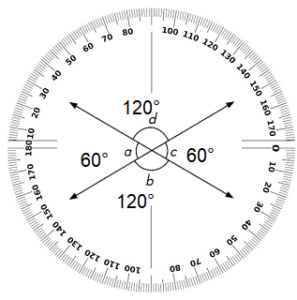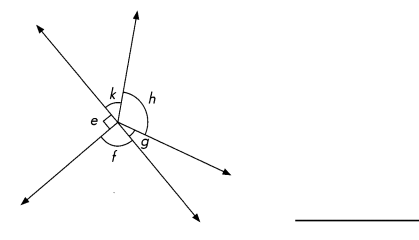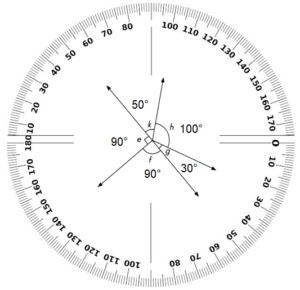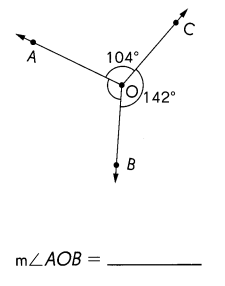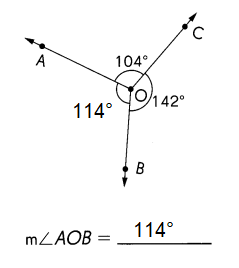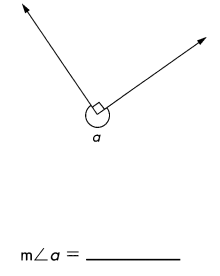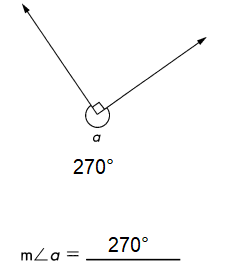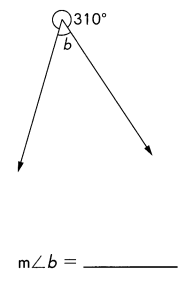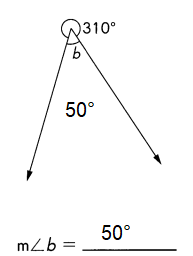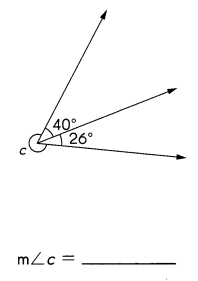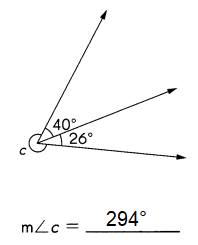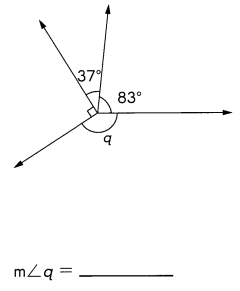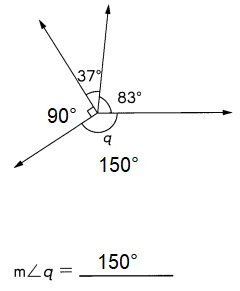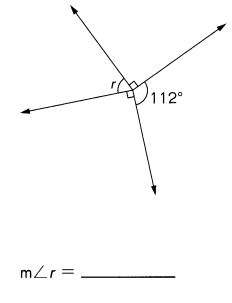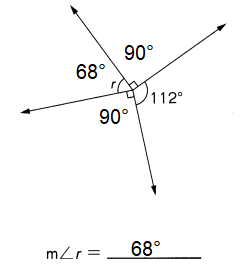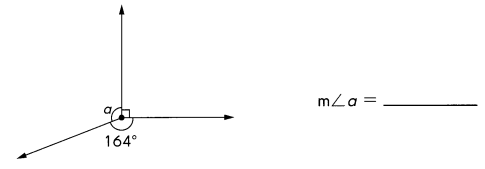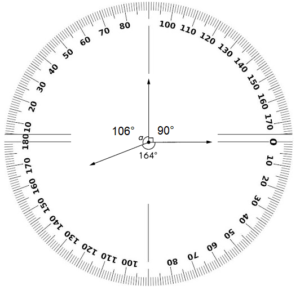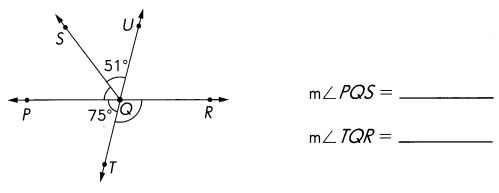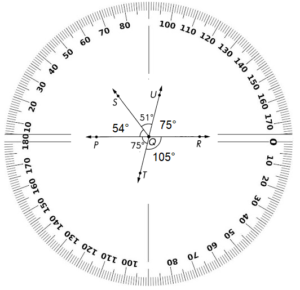Go through the Math in Focus Grade 5 Workbook Answer Key Chapter 1 Practice 1 Numbers to 10,000,000 to finish your assignments.
Math in Focus Grade 5 Chapter 1 Practice 1 Answer Key Numbers to 10,000,000
Count on or back by ten thousand or hundred thousand. Then fill in the blanks.
Question 1.
40,000 50,000 60,000 _____ ____
Answer:
Place value in Maths describes the position or place of a digit in a number. Each digit has a place in a number. When we represent the number in the general form, the position of each digit will be expanded. Those positions start from a unit place or we also call it one’s position. The order of place value of digits of a number of right to left is units, tens, hundreds, thousands, ten thousand, a hundred thousand, and so on.
The number 40,000:
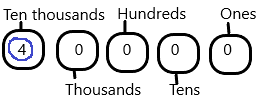
The ten thousand place value for 40,000 is 4.
The number 50,000:
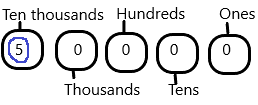
The ten thousand place value for 50,000 is 5.
The number 60,000:

The ten thousand place value for 60,000 is 6.
Question 2.
900,000 800,000 700,000 ___ _____
Answer:
Place value in Maths describes the position or place of a digit in a number. Each digit has a place in a number. When we represent the number in the general form, the position of each digit will be expanded. Those positions start from a unit place or we also call it one’s position. The order of place value of digits of a number of right to left is units, tens, hundreds, thousands, ten thousand, a hundred thousand, and so on.
The number 900,000:
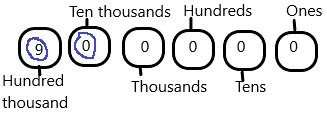
The hundred thousand place value for 900,000 is 9
The ten thousand place value for 900,000 is 0.
The number 800,000:
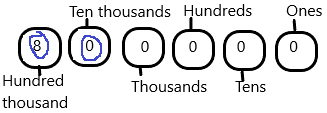
The hundred thousand place value for 800,000 is 8
The ten thousand place value for 800,000 is 0.
The number 700,000:
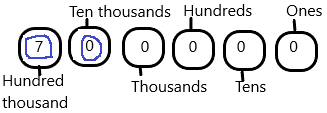
The hundred thousand place value for 700,000 is 7.
The ten thousand place value for 700,000 is 0.
Complete the table. Then write the number in standard form and in word form.
Question 3.
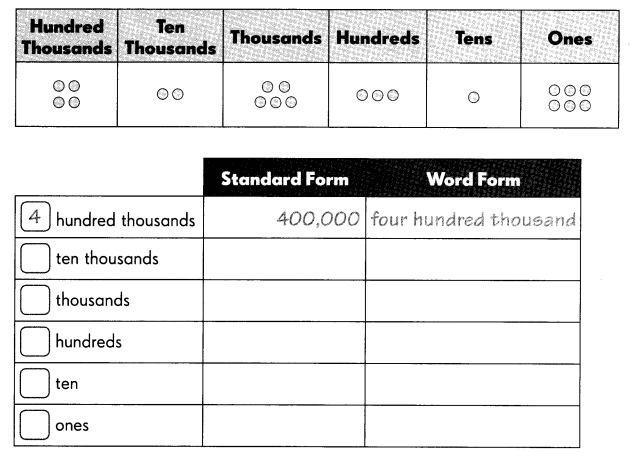
Number in standard form: ______
Number in word form: ______
Answer:
Place value in Maths describes the position or place of a digit in a number. Each digit has a place in a number. When we represent the number in the general form, the position of each digit will be expanded. Those positions start from a unit place or we also call it one’s position. The order of place value of digits of a number of right to left is units, tens, hundreds, thousands, ten thousand, a hundred thousand, and so on.
In Mathematics, place value charts help us to make sure that the digits are in the correct places. To identify the positional values of numbers accurately, first, write the digits in the place value chart and then write the numbers in the usual and the standard form.
PLACE VALUE CHART:
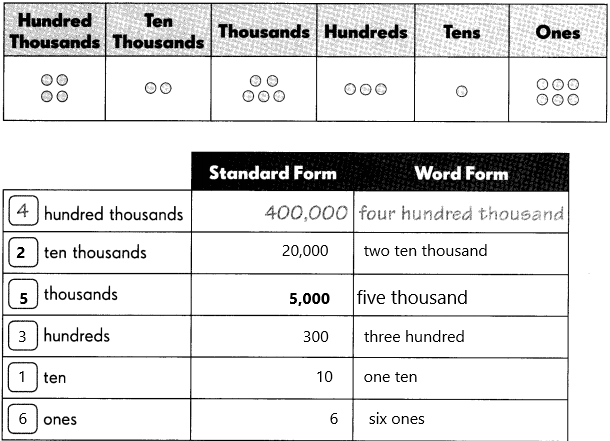
Number in standard form: 425,316
Number in word form: four hundred twenty-five thousand, three hundred sixteen.
Write each number in standard form.
Question 4.

The number is ____.
Answer: 239,653
Place value in Maths describes the position or place of a digit in a number. Each digit has a place in a number. When we represent the number in the general form, the position of each digit will be expanded. Those positions start from a unit place or we also call it one’s position. The order of place value of digits of a number of right to left is units, tens, hundreds, thousands, ten thousand, a hundred thousand, and so on.
In Mathematics, place value charts help us to make sure that the digits are in the correct places. To identify the positional values of numbers accurately, first, write the digits in the place value chart and then write the numbers in the usual and the standard form.
PLACE VALUE CHART:

Zeros may stand for nothing, but that doesn’t mean you can leave them out. They keep other digits in the correct places.
Think: 2 hundred thousands+3 ten thousands+9 thousands+6 hundreds+5 tens+3 ones
The standard form is 239,653.
Question 5.

The number is ____.
Answer: 835,720
Place value in Maths describes the position or place of a digit in a number. Each digit has a place in a number. When we represent the number in the general form, the position of each digit will be expanded. Those positions start from a unit place or we also call it one’s position. The order of place value of digits of a number of right to left is units, tens, hundreds, thousands, ten thousand, a hundred thousand, and so on.
In Mathematics, place value charts help us to make sure that the digits are in the correct places. To identify the positional values of numbers accurately, first, write the digits in the place value chart and then write the numbers in the usual and the standard form.
PLACE VALUE CHART:

Zeros may stand for nothing, but that doesn’t mean you can leave them out. They keep other digits in the correct places.
Think: 8 hundred thousands+3 ten thousands+5 thousands+7 hundreds+2 tens+0 ones
The standard form is 835,720.
Question 6.
eight hundred sixteen thousand, nine hundred forty-three _____
First, read the thousands period: eight hundred sixteen thousand – 816,000 Then, read the remaining period: nine hundred forty-three — 943
Answer: 816,943
Place value in Maths describes the position or place of a digit in a number. Each digit has a place in a number. When we represent the number in the general form, the position of each digit will be expanded. Those positions start from a unit place or we also call it one’s position. The order of place value of digits of a number of right to left is units, tens, hundreds, thousands, ten thousand, a hundred thousand, and so on.
In Mathematics, place value charts help us to make sure that the digits are in the correct places. To identify the positional values of numbers accurately, first, write the digits in the place value chart and then write the numbers in the usual and the standard form.
PLACE VALUE CHART:

Zeros may stand for nothing, but that doesn’t mean you can leave them out. They keep other digits in the correct places.
Think: 8 hundred thousands+1 ten thousands+6 thousands+9 hundreds+4 tens+3 ones
The standard form is 816,943.
Question 7.
six hundred five thousand, five hundred ____
Answer:
Place value in Maths describes the position or place of a digit in a number. Each digit has a place in a number. When we represent the number in the general form, the position of each digit will be expanded. Those positions start from a unit place or we also call it one’s position. The order of place value of digits of a number of right to left is units, tens, hundreds, thousands, ten thousand, a hundred thousand, and so on.
In Mathematics, place value charts help us to make sure that the digits are in the correct places. To identify the positional values of numbers accurately, first, write the digits in the place value chart and then write the numbers in the usual and the standard form.
PLACE VALUE CHART:

Zeros may stand for nothing, but that doesn’t mean you can leave them out. They keep other digits in the correct places.
Think: 6 hundred thousands+0 ten thousands+5 thousands+5 hundreds+0 tens+0 ones
The standard form is 605,500.
First, read the thousands of period: 605,000. Then, read the remaining period: 500.
Question 8.
one hundred three thousand, thirty-one ____
Answer:
Place value in Maths describes the position or place of a digit in a number. Each digit has a place in a number. When we represent the number in the general form, the position of each digit will be expanded. Those positions start from a unit place or we also call it one’s position. The order of place value of digits of a number of right to left is units, tens, hundreds, thousands, ten thousand, a hundred thousand, and so on.
In Mathematics, place value charts help us to make sure that the digits are in the correct places. To identify the positional values of numbers accurately, first, write the digits in the place value chart and then write the numbers in the usual and the standard form.
PLACE VALUE CHART:

Zeros may stand for nothing, but that doesn’t mean you can leave them out. They keep other digits in the correct places.
Think: 1 hundred thousands+0 ten thousands+3 thousands+0 hundreds+3 tens+1 ones
The standard form is 103,031.
Question 9.
eight hundred seventy thousand, three ____
Answer:
Place value in Maths describes the position or place of a digit in a number. Each digit has a place in a number. When we represent the number in the general form, the position of each digit will be expanded. Those positions start from a unit place or we also call it one’s position. The order of place value of digits of a number of right to left is units, tens, hundreds, thousands, ten thousand, a hundred thousand, and so on.
In Mathematics, place value charts help us to make sure that the digits are in the correct places. To identify the positional values of numbers accurately, first, write the digits in the place value chart and then write the numbers in the usual and the standard form.
PLACE VALUE CHART:

Zeros may stand for nothing, but that doesn’t mean you can leave them out. They keep other digits in the correct places.
Think: 8 hundred thousands+7 ten thousands+0 thousands+0 hundreds+0 tens+3 ones
Write: 870,003.
Say: Eight hundred seventy thousand three.
Question 10.
three hundred thousand, twelve ___
Answer: 300,012
Place value in Maths describes the position or place of a digit in a number. Each digit has a place in a number. When we represent the number in the general form, the position of each digit will be expanded. Those positions start from a unit place or we also call it one’s position. The order of place value of digits of a number of right to left is units, tens, hundreds, thousands, ten thousand, a hundred thousand, and so on.
In Mathematics, place value charts help us to make sure that the digits are in the correct places. To identify the positional values of numbers accurately, first, write the digits in the place value chart and then write the numbers in the usual and the standard form.
PLACE VALUE CHART:

Zeros may stand for nothing, but that doesn’t mean you can leave them out. They keep other digits in the correct places.
Think: 3 hundred thousands+0 ten thousands+0 thousands+0 hundreds+1 tens+2 ones
Write: 300,012
Say: Three hundred thousand twelve.
Fill in the headings. Write Tens, Hundreds, Ten Thousand, or Hundred Thousands. Then write each number in word form.
Question 11.

The number is _____
Answer:
Place value in Maths describes the position or place of a digit in a number. Each digit has a place in a number. When we represent the number in the general form, the position of each digit will be expanded. Those positions start from a unit place or we also call it one’s position. The order of place value of digits of a number of right to left is units, tens, hundreds, thousands, ten thousand, a hundred thousand, and so on.
In Mathematics, place value charts help us to make sure that the digits are in the correct places. To identify the positional values of numbers accurately, first, write the digits in the place value chart and then write the numbers in the usual and the standard form.

Zeros may stand for nothing, but that doesn’t mean you can leave them out. They keep other digits in the correct places.
Think: 1 hundred thousands+0 ten thousands+5 thousands+3 hundreds+6 tens+2 ones
Write: 105,362.
Say One hundred five thousand, three hundred sixty-two.
Question 12.

The number is _____
Answer:
Place value in Maths describes the position or place of a digit in a number. Each digit has a place in a number. When we represent the number in the general form, the position of each digit will be expanded. Those positions start from a unit place or we also call it one’s position. The order of place value of digits of a number of right to left is units, tens, hundreds, thousands, ten thousand, a hundred thousand, and so on.
In Mathematics, place value charts help us to make sure that the digits are in the correct places. To identify the positional values of numbers accurately, first, write the digits in the place value chart and then write the numbers in the usual and the standard form.

Zeros may stand for nothing, but that doesn’t mean you can leave them out. They keep other digits in the correct places.
Think: 5 hundred thousands+6 ten thousands+0 thousands+0 hundreds+2 tens+1 ones
Write:560,021.
Say five hundred sixty thousand, twenty-one.
Write each number in word form.
65,000 — sixty-five thousand
142 — one hundred forty-two
Question 13.
65, 142 _____
Answer:
Numbers in words are written using the English alphabet. Numbers can be expressed both in words and figures. For example, 100,000 in words is written as One Lakh or One hundred thousand. Numbers in words can be written for all the natural numbers, based on the place value of digits, such as ones, tens, hundreds, thousands, and so on.
The number 65,142 can be written in word form as:
sixty-five thousand, one hundred forty-two.
Zeros may stand for nothing, but that doesn’t mean you can leave them out. They keep other digits in the correct places.

The given number 65,142: o hundred thousand+6 ten thousand+5 thousand+1 hundred+4 tens+2 ones.
Write: 65,142
Say: Sixty-five thousand, one hundred forty two.
Question 14.
368,400 _____
Answer:
Numbers in words are written using the English alphabet. Numbers can be expressed both in words and figures. For example, 100,000 in words is written as One Lakh or One hundred thousand. Numbers in words can be written for all the natural numbers, based on the place value of digits, such as ones, tens, hundreds, thousands, and so on.
The number 368,400 can be written in word form as:
Three hundred sixty-eight thousand, four hundred.
Zeros may stand for nothing, but that doesn’t mean you can leave them out. They keep other digits in the correct places.

The given number 368,400: 3 hundred thousand+6 ten thousand+8 thousand+4 hundred+0 tens+0 ones.
Write: 368,400
Say: Three hundred sixty-eight thousand, four hundred.
Complete to express each number in word form.
Question 15.
802,101 eight hundred two thousand, one hundred _________
Answer:
Numbers in words are written using the English alphabet. Numbers can be expressed both in words and figures. For example, 100,000 in words is written as One Lakh or One hundred thousand. Numbers in words can be written for all the natural numbers, based on the place value of digits, such as ones, tens, hundreds, thousands, and so on.
1. Place value tells you how much each digit stands for
2. Use a hyphen when you use words to write 2-digit numbers greater than 20 that have a digit other than zero in the one’s place.
3. A place-value chart tells you how many hundreds, tens, and ones to use.
The given number is 802,101 and this can be written in word form as:
Eight hundred two thousand, one hundred one.
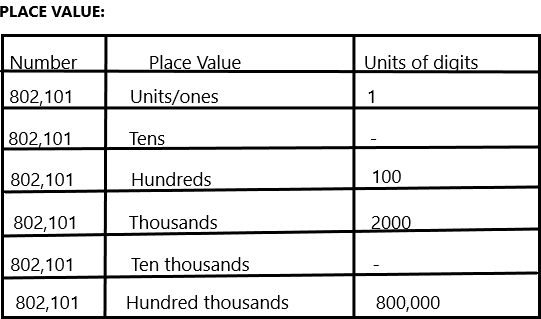
Question 16.
324,306 three hundred twenty-four ____, three hundred six
Answer:
Numbers in words are written using the English alphabet. Numbers can be expressed both in words and figures. For example, 100,000 in words is written as One Lakh or One hundred thousand. Numbers in words can be written for all the natural numbers, based on the place value of digits, such as ones, tens, hundreds, thousands, and so on.
1. Place value tells you how much each digit stands for
2. Use a hyphen when you use words to write 2-digit numbers greater than 20 that have a digit other than zero in the one’s place.
3. A place-value chart tells you how many hundreds, tens, and ones to use.
The given number is 324,306 and this can be written in word form as:
Three hundred twenty-four thousand, three hundred six.
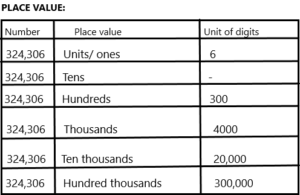
Question 17.
150,260 one hundred fifty thousand, ___ hundred sixty
Answer:
Numbers in words are written using the English alphabet. Numbers can be expressed both in words and figures. For example, 100,000 in words is written as One Lakh or One hundred thousand. Numbers in words can be written for all the natural numbers, based on the place value of digits, such as ones, tens, hundreds, thousands, and so on.
1. Place value tells you how much each digit stands for
2. Use a hyphen when you use words to write 2-digit numbers greater than 20 that have a digit other than zero in the one’s place.
3. A place-value chart tells you how many hundreds, tens, and ones to use.
The given number is 150, 260 and this can be written in word form as:
One hundred fifty thousand, two hundred sixty.
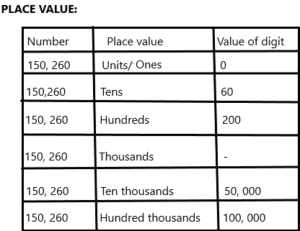
Question 18.
999,1 98 nine hundred ___ thousand, one hundred ______________
Answer:
Numbers in words are written using the English alphabet. Numbers can be expressed both in words and figures. For example, 100,000 in words is written as One Lakh or One hundred thousand. Numbers in words can be written for all the natural numbers, based on the place value of digits, such as ones, tens, hundreds, thousands, and so on.
- Place value tells you how much each digit stands for
- Use a hyphen when you use words to write 2-digit numbers greater than 20 that have a digit other than zero in the one’s place.
- A place-value chart tells you how many hundreds, tens, and ones to use.
The given number is 999,198 and this can be written in word form as:
Nine hundred ninety thousand, one hundred ninety-eight.
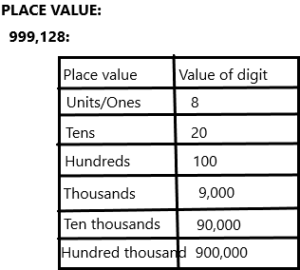
Use the table showing the populations of some cities to answer the questions.
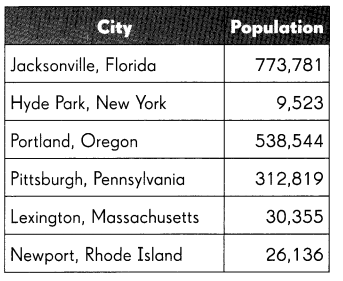
Use the table showing the populations of some cities to answer the questions.
Question 19.
Write the population of Pittsburgh in word form.
Answer:
Numbers in words are written using the English alphabet. Numbers can be expressed both in words and figures. For example, 100,000 in words is written as One Lakh or One hundred thousand. Numbers in words can be written for all the natural numbers, based on the place value of digits, such as ones, tens, hundreds, thousands, and so on.
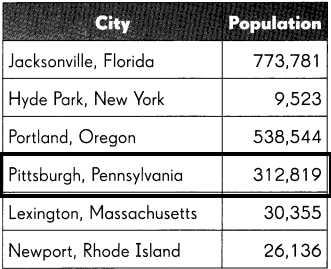
The population in Pittsburgh is 312,819.
In the word form, we can write as Three lakh twelve thousand eight hundred and nineteen.
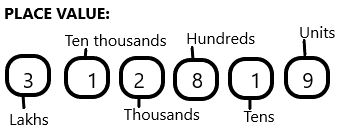
Question 20.
Which city has the least population? What is its population?
Answer: Hyde Park, New York.
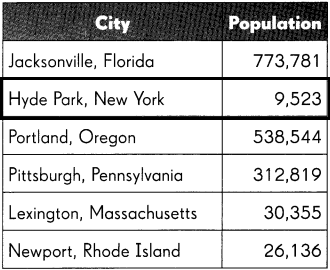
The least population of the city is Hyde Park, New York. And the population is 9,523.
The place value starts from thousands when compared to all the place values that’s why I choose New York which has the lowest population.
